親鸞と浄土真宗の誕生 承元の法難 六角夢告『教行信証』 の教え
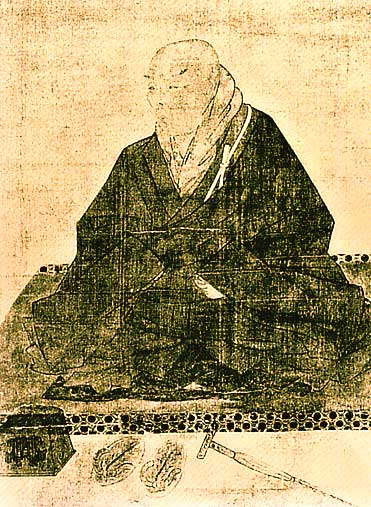
The Birth of Shinran and Jodo Shinshu: Jo-ei Persecution and the Teachings of Rokkaku Myogo’s “Kyogyoshinsho”
イントロダクション
親鸞聖人の思想と浄土真宗の創始は、日本仏教史上において画期的な出来事とされています。
承元の法難を経て、彼の信仰と実践の道が確立されました。
『教行信証』はその教えを集大成した文献であり、六角夢告は親鸞の宗教的体験として重要視されています。
このブログでは、これらの要素が浄土真宗の誕生にどのように寄与したかを探ります。
親鸞とは-浄土真宗の宗祖の軌跡
親鸞は浄土真宗の創始者として知られ、その生涯は日本の宗教史において重要な位置を占めています。
彼の生きた時代は、保元の乱や平治の乱によって貴族社会が揺れ動いていた時期であり、これらの混乱が親鸞の思想に影響を与えたと考えられています。
生まれたのは平安時代末期で、若い頃から仏教に深い関心を持ち、比叡山延暦寺で出家し、厳しい修行を積みました。
その後、六角夢告と呼ばれる神秘的な体験を通して、自身の信仰に大きな転機を迎えることになります。
鎌倉時代に入ると、親鸞は師である法然と共に承元の法難により配流され、東国で平家の残党と出会い、浄土真宗の教えを広めることに尽力しました。
この時期には、後鳥羽上皇との関係も注目されます。
親鸞が著した『教行信証』は、浄土真宗の教義を体系的にまとめた重要な文献であり、後世の信者に大きな影響を与えました。
彼の入滅後も、その教えは多くの人々に受け継がれ、今日に至るまで日本の宗教風景に色濃く存在しています。
親鸞の教えは、仏教の普遍的な救済のメッセージとして、時代を超えて多くの心に響き続けています。
Introduction
The Thought of Shinran and the Founding of Jodo Shinshu in Japanese Buddhist history are considered pivotal events.
Following the Jo-ei Persecution, his path of faith and practice was firmly established.
“Kyogyoshinsho” represents a comprehensive document of his teachings, while Rokkaku Myogo’s revelations are valued as significant religious experiences of Shinran.
This blog explores how these elements contributed to the birth of Jodo Shinshu.
Shinran: Founder of Jodo Shinshu
Shinran, renowned as the founder of Jodo Shinshu, occupies a crucial place in Japan’s religious history.
His life unfolded during a turbulent period marked by the Hogen and Heiji Rebellions, upheavals that significantly influenced Shinran’s ideology.
Born in the late Heian period, from a young age he showed profound interest in Buddhism, eventually ordaining at Mt. Hiei’s Enryaku-ji and undergoing rigorous ascetic practices.
Later, a mystical experience known as Rokkaku Myogo brought a profound transformation to his faith.
Entering the Kamakura period, Shinran was exiled alongside his mentor, Honen, during the Jo-ei Persecution, where he encountered remnants of the Taira clan in eastern Japan and worked tirelessly to spread the teachings of Jodo Shinshu.
His relationship with retired Emperor Gotoba during this period is also noteworthy.
Shinran’s magnum opus, “Kyogyoshinsho,” systematically summarizes the doctrines of Jodo Shinshu and profoundly influenced later adherents.
Even after his passing, his teachings were embraced by many, shaping Japan’s religious landscape to this day.
Shinran’s teachings continue to resonate deeply across generations as a universal message of Buddhist salvation.

Seirin-in Temple (Shinden) Hall of Elegance
時代背景-保元の乱と平治の乱の影響
保元の乱と平治の乱は、日本の歴史において重要な転換点となりました。
これらの乱を背景に、親鸞は後に浄土真宗の宗祖として知られることになる人物の生涯が始まります。
親鸞は比叡山延暦寺での厳しい修行を経て、六角夢告という神秘的な体験を通じて新たな宗教的視点を得ることになります。
平家の台頭とその後の没落は、親鸞にとって重要な時代の流れでした。
この時代の政治的な混乱は、彼の思想にも影響を与え、後に『教行信証』という著作に結実します。
また、鎌倉時代の動乱の中で、親鸞は師弟配流の苦難を経験し、東国での布教活動を行います。
後鳥羽上皇との関わりは、親鸞の人生においても大きな転機となりました。
承元の法難は、仏教界における権力闘争の一例であり、親鸞の立ち位置を決定づける出来事であったと言えるでしょう。
親鸞の死後、彼の教えは多くの人々に受け継がれ、浄土真宗は日本の宗教風景の中で大きな流れを形成することになります。
保元の乱と平治の乱がもたらした時代の変動は、親鸞の生きた時代を理解する上で欠かせない要素であり、彼の思想にも大きな影響を与えたのです。
誕生と若き日の親鸞
親鸞は浄土真宗の創始者として広く知られています。
彼の生涯は、平安時代末期から鎌倉時代にかけての激動の時代背景の中で展開しました。
保元の乱や平治の乱といった政治的な混乱は、社会に大きな影響を及ぼし、親鸞の思想形成にも影を落としています。
親鸞は1173年に京都で生まれ、若くして出家しました。
彼が修行を積んだ比叡山延暦寺は、その時代の仏教学の中心地であり、多くの学僧が集まる場所でした。
ここでの修行は親鸞の精神性を深める重要な時期となりました。
特に注目すべきは、親鸞が体験した六角夢告です。
この神秘的な体験は、彼の人生における大きな転機となり、後の布教活動へとつながるきっかけとなりました。
時は流れ、鎌倉時代が始まると、親鸞は師である法然と共に承元の法難により配流されます。
この苦難の中で、彼は東国で平家の遺族と出会い、彼らに教えを説きました。
その後、帰京した親鸞は後鳥羽上皇との関わりを持ちながら、『教行信証』を著し、浄土真宗の教えを確立しました。
彼の入滅後も、その教えは多くの人々に受け継がれ、今日に至るまで影響を与え続けています。
親鸞の教えは、苦悩する人々に希望の光を与え、歴史を通じて日本の精神文化に深い足跡を残しました。
Background: The Influence of the Hōgen and Heiji Rebellions
The Hōgen and Heiji Rebellions marked significant turning points in Japanese history.
Against this backdrop, the life of Shinran, who would later be known as the founder of Jodo Shinshu Buddhism, began to unfold.
Shinran underwent rigorous training at Mount Hiei’s Enryaku-ji Temple and had a mystical experience known as the “Six-Character Invocation.”
The rise and fall of the Taira clan during this period were pivotal for Shinran’s philosophical development.
These political upheavals influenced his thoughts and eventually culminated in his seminal work, “Kyōgyōshinshō.”
During the turbulent Kamakura period, Shinran faced exile with his teacher Hōnen due to the Kenmu Restoration, spreading Jodo Shinshu teachings in eastern Japan.
His relationship with Emperor Go-Toba was also noteworthy during this period.
The challenges of the Kenmu Restoration exemplified the power struggles within the Buddhist community and defined Shinran’s role.
After Shinran’s passing, his teachings were embraced by many, shaping the landscape of Japanese religion.
The historical changes brought about by the Hōgen and Heiji Rebellions were crucial in understanding Shinran’s era and deeply influenced his philosophy.
Birth and Youth of Shinran
Shinran is widely recognized as the founder of Jodo Shinshu Buddhism.
His life unfolded during a tumultuous period from the late Heian period to the early Kamakura period.
Political turmoil, such as the Hōgen and Heiji Rebellions, profoundly affected society and shaped Shinran’s ideological development.
Born in Kyoto in 1173, Shinran entered monastic life at a young age.
The training he received at Mount Hiei’s Enryaku-ji Temple, a center of Buddhist learning at the time, was pivotal in shaping his spirituality.
Of particular significance was Shinran’s mystical experience known as the “Six-Character Invocation,” which became a turning point in his life and laid the foundation for his later missionary work.
As the Kamakura period unfolded, Shinran faced exile with his teacher Hōnen due to political strife, encountering remnants of the Taira clan in eastern Japan and spreading his teachings among them.
Upon returning to Kyoto, Shinran established his teachings through works like the “Kyōgyōshinshō,” while also engaging with Emperor Go-Toba.
Even after his passing, Shinran’s teachings continued to influence many people and have left a lasting impact on Japan’s cultural and spiritual landscape.
Shinran’s teachings offered a beacon of hope to those in distress and left a profound mark on Japan’s spiritual and cultural heritage throughout history.

Seikoin Site: The Western Pagoda of Enryaku-ji Temple on Mount Hiei
出家と比叡山延暦寺での修行
彼の人生は保元の乱や平治の乱といった政治的混乱の中で始まり、若き日には比叡山延暦寺での厳しい修行を経験しました。
この期間は親鸞にとって大きな精神的成長の場となり、後の教えの基盤を築くことに役立ちました。
比叡山延暦寺での修行は、親鸞にとっての転機であり、ここで彼は六角夢告という神秘体験を通じて、自身の宗教観を深めるきっかけを得ました。
その後、師弟としての配流生活を経て、鎌倉時代の動乱の中で東国に布教活動を展開していきます。
この時期には平家との出会いがあり、それが彼の教えに新たな視点をもたらしたと言われています。
親鸞は後鳥羽上皇とも関わりを持ち、その影響は彼の著作『教行信証』にも見受けられます。
このテキストは浄土真宗の教義を体系化したものとして、今日に至るまで多くの人々に読み継がれています。
彼の入滅後も、親鸞の教えは多くの人々に影響を与え続け、浄土真宗は日本仏教の一大宗派としてその地位を確立しました。
親鸞の生涯は、混沌とした時代の中での信仰の追求と、個人の内面的成長の物語です。
彼が比叡山延暦寺での修行を経て、後の布教活動に至るまでの過程は、仏教哲学を深く理解する上で欠かせない知識と言えるでしょう。
六角夢告-転機となった神秘体験
親鸞は浄土真宗の宗祖として知られ、その生涯は多くの転機に満ちていました。
その中でも、六角夢告は彼の宗教観に大きな影響を与えた神秘体験として特筆されます。
親鸞が生きた時代は、保元の乱や平治の乱といった政治的な混乱が頻繁に起こり、社会は不安定な状態にありました。
若き日の親鸞は、比叡山延暦寺での厳しい修行を経て、仏教の深い理解を深めていきました。
特に六角夢告は、彼が出家後の宗教的な指針を定める上での重要な出来事でした。
この体験を通じて、親鸞は後に浄土真宗の教えを確立することになります。
また、鎌倉時代の動乱の中で、親鸞は師弟配流の苦難を経験し、その過程で平家との出会いがありました。
この時期の経験が、彼の布教活動における人々への深い共感と理解を生み出す基盤となりました。
帰京した親鸞は、後鳥羽上皇との関わりを持ち、その交流は彼の宗教活動に影響を与えたとされています。
親鸞の死後も、彼の教えは『教行信証』などの著作を通じて多くの人々に受け継がれ、今日に至るまで浄土真宗の信仰として根強く残っています。
承元の法難の時期にも、親鸞の信念は試されましたが、彼は決して自らの信仰を曲げることはありませんでした。
親鸞の教えは、単なる宗教的な枠組みを超え、人々の心の支えとなり、日本の宗教史において重要な位置を占めています。
Monastic Life and Training at Mt. Hiei Enryaku-ji Temple
His life began amidst political turmoil like the Hōgen Rebellion and Heiji Rebellion, and in his youth, he underwent rigorous training at Mt. Hiei Enryaku-ji Temple.
This period was pivotal for Shinran’s spiritual growth, laying the foundation for his later teachings.
Training at Mt. Hiei Enryaku-ji was a turning point for Shinran, where he had a mystical experience known as the “Six-Angle Dream Revelation,” deepening his religious perspective.
Subsequently, amidst the turmoil of the Kamakura period, he engaged in missionary activities in eastern Japan after experiencing exile with his teacher.
During this time, encounters with remnants of the Taira clan profoundly influenced his teachings, bringing new insights.
Shinran also had associations with Emperor Go-Toba, evident in his seminal work “Kyōgyōshinshō,” which systematized the doctrines of Jōdo Shinshū Buddhism and continues to be studied by many today.
Even after his passing, Shinran’s teachings continued to influence people significantly, firmly establishing Jōdo Shinshū as a major Buddhist sect in Japan.
Shinran’s life is a story of spiritual pursuit amidst turbulent times, from his training at Mt. Hiei Enryaku-ji to his later missionary efforts, essential for understanding Buddhist philosophy deeply.
The Six-Angle Dream Revelation: A Pivotal Mystical Experience
Shinran, renowned as the founder of Jōdo Shinshū, lived a life marked by numerous pivotal moments.
Among these, the Six-Angle Dream Revelation stands out as a mystical experience that profoundly shaped his religious views.
Shinran lived in an era plagued by political instability, including the Hōgen and Heiji Rebellions, which frequently disrupted society.
In his youth, Shinran’s rigorous training at Mt. Hiei Enryaku-ji deepened his understanding of Buddhism.
The Six-Angle Dream Revelation, in particular, was a significant event that established the spiritual guidelines for his life post-monasticism.
Through this experience, Shinran later founded the teachings of Jōdo Shinshū Buddhism.
Moreover, amidst the turmoil of the Kamakura period, Shinran experienced the hardships of exile with his teacher, encountering remnants of the Taira clan in the process.
These experiences during this period formed the foundation for his profound empathy and understanding in his missionary work.
Upon returning to Kyoto, Shinran had connections with Emperor Go-Toba, whose influence is evident in his religious activities.
Even after Shinran’s passing, his teachings, notably documented in “Kyōgyōshinshō,” continued to be passed down and remain a resilient faith of Jōdo Shinshū.
During the challenging period of the Jōgen no Ran, Shinran’s faith was tested, yet he never wavered in his beliefs.
Shinran’s teachings transcend mere religious frameworks, offering spiritual support to people and holding a significant place in Japan’s religious history.
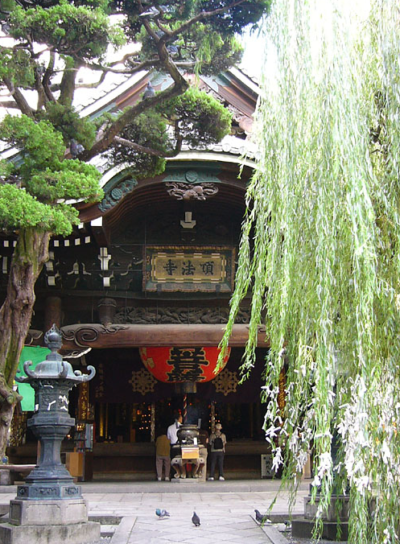
Tōfuku-ji Temple (Rokkakudō) Main Hall
師弟配流と鎌倉時代の動乱
親鸞は、浄土真宗の宗祖として知られ、その生涯は鎌倉時代の複雑な歴史的背景と深く結びついています。
保元の乱や平治の乱といった政治的混乱は、親鸞の思想形成に影響を与えたとされています。
彼の誕生から若き日々にかけての経緯は、当時の社会状況を反映しており、出家後の比叡山延暦寺での修行は、その後の彼の宗教的活動の基盤を築いたと言えるでしょう。
特に注目すべきは、六角夢告と呼ばれる神秘体験が親鸞の人生における転機となったことです。
この出来事を経て、親鸞は師弟配流という形で鎌倉時代の動乱の中、東国へと足を運びます。
この時期には平家との重要な出会いがあり、それは彼の布教活動における大きな転機となりました。
帰京後、後鳥羽上皇との関わりも親鸞の生涯において重要な要素であり、承元の法難という事件を通じて、彼の宗教観がより一層深まったと考えられています。
親鸞の教えは、『教行信証』という著作に集約されており、浄土真宗の教義を後世に伝える重要な文献となっています。
親鸞の入滅後も、彼の教えは数多くの人々に影響を与え続け、今日に至るまで浄土真宗は多くの信者に支持されています。
彼の生涯と教えが、鎌倉時代の混沌とした時代背景の中でどのように形成され、発展していったのかを追うことは、日本の宗教史を理解する上で非常に価値のあることです。
東国布教-平家との出会い
親鸞は浄土真宗の創始者として知られ、その生涯は多くの歴史的転換点に彩られています。
保元の乱や平治の乱といった政治的混乱の時代を背景に、親鸞は誕生しました。
若き日の親鸞は、比叡山延暦寺での厳しい修行を経て、仏教の深遠な教えに触れました。
特に注目すべきは、六角夢告と呼ばれる神秘的な体験が親鸞の人生に大きな転機をもたらしたことです。
この体験後、師である法然と共に配流された親鸞は、鎌倉時代の動乱の中で東国へと布教活動を広げました。
この時期には平家との重要な出会いがあり、それが浄土真宗の教えの広がりに大きな影響を与えました。
親鸞の東国布教は、承元の法難という仏教界の迫害を経てもなお、力強く進められました。
そして帰京後、後鳥羽上皇との関わりを持ちながらも、独自の教えを確立し、多くの著作を残しました。
その中でも『教行信証』は、親鸞の思想を集大成した重要な文献とされています。
親鸞の入滅後も、浄土真宗は多くの人々に受け継がれ、今日に至るまで日本の仏教界において大きな足跡を残しています。
彼の教えは、時代を超えて多くの人々の心に響く普遍的なメッセージを持っているのです。
Shitei Exile and the Turmoil of the Kamakura Period
Shinran, known as the founder of Jodo Shinshu (Pure Land Buddhism), had a life deeply intertwined with the complex historical backdrop of the Kamakura period in Japan.
Born amidst political turmoil such as the Hōgen Rebellion and Heiji Rebellion, these formative years of Shinran’s life reflected the societal upheavals of the time. His rigorous training at Mt. Hiei’s Enryaku-ji Temple after entering monkhood laid the foundation for his later religious activities.
Of particular note is the mystical experience known as Rokkaku-dream, which became a pivotal moment in Shinran’s life, shaping his religious perspectives. Subsequently, during the chaos of the Kamakura period, Shinran embarked on missionary work in the eastern provinces under the hardships of exile alongside his teacher. It was during this period that he encountered remnants of the Taira clan, a significant turning point in his mission.
Upon returning to Kyoto, his interactions with Emperor Go-Toba were crucial in deepening his religious insights, particularly highlighted during the period of the Shōgen Disturbance, an event that solidified Shinran’s position within the Buddhist community.
Shinran’s teachings, encapsulated in works such as “Kyōgyōshinshō,” remain vital texts transmitting the doctrines of Jodo Shinshu to future generations. Even after his passing, Shinran’s teachings continued to influence countless individuals, firmly establishing Jodo Shinshu as a major Buddhist sect in Japan.
Understanding how Shinran’s life and teachings were shaped and developed amidst the chaotic backdrop of the Kamakura period provides invaluable insights into Japan’s religious history and the enduring universal message of his teachings.
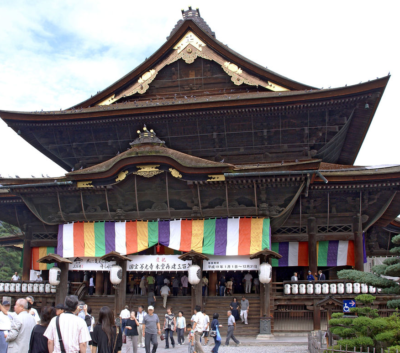
Zenkoji Main Hall
帰京と後鳥羽上皇との関わり
親鸞は、日本仏教史において重要な位置を占める浄土真宗の開祖です。
彼の生涯は、保元の乱や平治の乱といった政治的混乱の時代に始まりました。
これらの事件は、平安末期から鎌倉時代にかけての社会状況を反映しており、親鸞の思想形成にも影響を与えたと考えられます。
若い頃に出家を果たし、比叡山延暦寺で修行を積んだ彼は、六角夢告という神秘体験を経て、自身の宗教観を深めました。
鎌倉時代の政治的な動乱の中、親鸞は師である法然と共に配流され、その間に平家の遺族との出会いを果たし、彼らに教えを説きました。
この時期には承元の法難も発生し、仏教界における新旧の対立が顕著になっていました。
後鳥羽上皇との関わりは、帰京後に特に重要となります。
親鸞は後鳥羽上皇の時代に、『教行信証』を著し、浄土真宗の教義を体系化しました。
この文献は後世に大きな影響を与え、親鸞の教えが広く受け入れられるきっかけとなりました。
親鸞の入滅後、彼の教えは多くの人々によって継承され、今日に至るまで浄土真宗は多くの信者に支持されています。
彼の生涯と業績は、日本の宗教史だけでなく、文化史においても大きな足跡を残しており、その研究は今なお続けられています。
親鸞の思想と行動は、混沌とした時代の中で一筋の光を見出し、人々に希望と慰めを提供したのです。
入滅とその後の影響
親鸞は浄土真宗の宗祖として知られ、その教えは日本仏教史において重要な位置を占めています。
彼の生涯は、保元の乱や平治の乱といった政治的混乱の時代に始まりました。
これらの出来事は、当時の社会構造に大きな影響を与え、親鸞の思想形成にも影響を及ぼしました。
比叡山延暦寺での厳しい修行を経て、親鸞は六角夢告という神秘的な体験を通じて、自身の信仰の方向性を見出しました。
この出来事は彼の人生における転機となり、その後の布教活動に大きな影響を与えました。
承元の法難の時期には、鎌倉時代の政治的な動乱が激しさを増し、多くの僧侶が迫害を受けました。
親鸞もまた、この波乱に巻き込まれ、師弟と共に配流される苦難を経験しました。
この時期には平家との出会いもあり、彼らとの関わりが親鸞の教えに影響を与えることとなりました。
後鳥羽上皇との関係も親鸞の生涯において重要な部分を占め、当時の権力者との交流は彼の宗教活動における障害となることもありました。
しかし、これらの困難を乗り越えた親鸞は、最終的には京都に帰京し、その後は『教行信証』という著作を通じて浄土真宗の教えを広めることに尽力しました。
親鸞の入滅後、彼の教えはさらに広がりを見せ、浄土真宗は日本仏教の中で大きな流れとなりました。
彼の教えは、死後も多くの人々に深い影響を与え続け、今日に至るまでその思想は多くの信者によって受け継がれています。
親鸞の生涯とその教えは、日本の宗教文化において不可欠な要素であり、その後の影響は計り知れないものがあります。
Return to Kyoto and Interaction with Emperor Gotoba
Shinran, known as the founder of Jodo Shinshu in Japanese Buddhist history, began his life during the turbulent times of the Hogen and Heiji Rebellions.
These events reflected the social conditions of the late Heian period and influenced Shinran’s ideological development.
After entering priesthood at a young age and undergoing rigorous training at Mount Hiei’s Enryakuji Temple, he had a profound mystical experience known as the “six-cornered dream.”
Amid the political turmoil of the Kamakura period, Shinran was exiled with his teacher Honen and encountered survivors of the defeated Taira clan, whom he taught.
This period coincided with the difficulties of the Jokyu Disturbance, a time of persecution in the Buddhist community.
Shinran’s association with Emperor Gotoba, particularly during his return to Kyoto, was pivotal.
During Emperor Gotoba’s reign, Shinran authored the “Kyogyoshinsho,” which systematized the doctrine of Jodo Shinshu and greatly influenced subsequent generations.
Even after Shinran’s passing, his teachings were passed down by many and Jodo Shinshu continued to gather numerous adherents, supporting them in their faith.
Shinran’s life and contributions not only shaped Japanese religious history but also left an indelible mark on cultural history, continuing to be studied and revered to this day.
Passing and Subsequent Influence
Shinran is renowned as the founder of Jodo Shinshu, holding a significant place in Japanese Buddhist history.
His life began amidst the political upheavals of the Hogen and Heiji Rebellions, events that had profound effects on contemporary society and influenced Shinran’s philosophical development.
After rigorous training at Mount Hiei’s Enryakuji Temple, Shinran experienced a pivotal mystical event known as the “six-cornered dream,” which guided his spiritual direction.
During the tumultuous Jokyu Disturbance, Shinran, like many monks, faced persecution as the Kamakura period’s political turmoil intensified.
Encountering the Taira clan during this period was significant, shaping Shinran’s teachings and experiences.
His relationship with Emperor Gotoba was crucial, marking a significant aspect of Shinran’s life, albeit presenting challenges in his religious endeavors.
Despite these hardships, Shinran eventually returned to Kyoto, dedicating himself to propagating Jodo Shinshu teachings through seminal works such as the “Kyogyoshinsho.”
Following Shinran’s passing, his teachings expanded further, solidifying Jodo Shinshu as a major current within Japanese Buddhism.
His teachings continue to resonate deeply with many individuals, transcending time to influence countless believers today.
Shinran’s life and teachings remain integral to Japanese religious culture, with their ongoing impact being immeasurable.
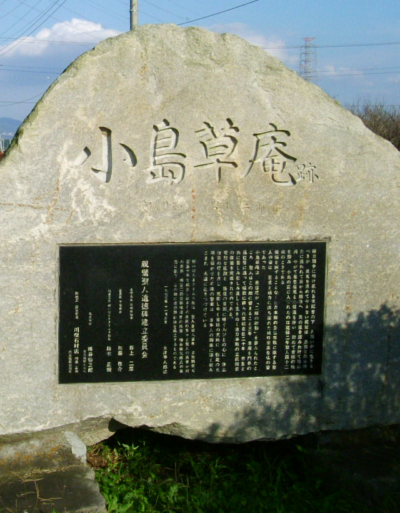
Remains of Kojima’s Hermitage – Historical Site
浄土真宗の誕生と発展
浄土真宗は、日本の鎌倉時代に親鸞によって創始された仏教宗派です。
親鸞は浄土真宗の宗祖とされ、彼の教えは後世に大きな影響を与えました。
その教えの確立は、保元の乱や平治の乱といった政治的混乱の時代背景の中で、比叡山延暦寺での修行を経て形成されていきます。
親鸞は平家の台頭と衰退を目の当たりにし、その経験が浄土真宗の教義に反映されたと考えられています。
承元の法難においては、後鳥羽上皇の命により、親鸞は遠流の身となりました。
この宗教的迫害の中で、彼は六角夢告を受け、その後の教えの展開に大きな影響を受けることになります。
『教行信証』は親鸞が記した代表的な著作であり、浄土真宗の教義を集大成したものとされています。
この文献は、浄土真宗の信仰の核心を明らかにし、後の教団の発展に不可欠な基盤を提供しました。
浄土真宗は、親鸞の死後も各派本山の成立と展開を遂げ、日本の宗教風土の中で根強い信仰を築き上げていきました。
現代においても、その教えは多くの人々に受け入れられ、評価されています。
浄土真宗の発展は、親鸞の生涯と彼が残した教義の深い理解を通じて、その全貌を探ることができます。
承元の法難-宗教的迫害の中での教えの確立
承元の法難は、鎌倉時代の宗教的迫害の一環であり、浄土真宗の宗祖である親鸞の教えが確立される重要な背景となりました。
この出来事は、後鳥羽上皇の命により、比叡山延暦寺の僧侶を中心とした仏教勢力が、新興宗教の動きを弾圧しようとした事件です。
親鸞はこの法難により、六角夢告に従い、遠く離れた越後に流罪となりましたが、これが彼の教えをより深め、後に『教行信証』を著す契機となりました。
浄土真宗は、親鸞の教えを核として、その後の日本の宗教風土に大きな影響を与えていきます。
承元の法難を経て、保元の乱や平治の乱のような政治的混乱の中でも、平家による支配が終焉を迎える中、浄土真宗は信者の間で広く受け入れられるようになりました。
また、宗派の成立と展開は、比叡山延暦寺とは異なる宗教観を打ち出し、多くの人々に新たな宗教的選択肢を提供したのです。
現代においても、親鸞の教えと浄土真宗の影響は色褪せることなく、多くの人々によって評価され、受け入れられ続けています。
その教義の普遍性と、生死を超えた救済のメッセージは、時代を超えて現代人の心に響くものがあります。
承元の法難を乗り越えた親鸞の精神は、今日においても多くの人々にとって、大きな希望と慰めを与えているのです。
Birth and Development of Jodo Shinshu
Jodo Shinshu, founded by Shinran during Japan’s Kamakura period, holds a significant place in Japanese Buddhist history.
Shinran, revered as the founder of Jodo Shinshu, profoundly influenced future generations with his teachings.
His doctrines took shape during a tumultuous era marked by political unrest such as the Hogen and Heiji Rebellions, against the backdrop of which he underwent rigorous training at Mount Hiei’s Enryakuji Temple.
Witnessing the rise and fall of the Taira clan, Shinran’s experiences were reflected in the tenets of Jodo Shinshu.
During the religious persecution of the Jo Gen Incident, at the behest of Emperor Gotoba, Shinran was exiled to Echigo, where he underwent the mystical experience known as the Six Realms Dream, profoundly shaping his subsequent teachings.
His seminal work, “Kyogyoshinsho,” consolidated his teachings into the core doctrines of Jodo Shinshu, laying an essential foundation for the sect’s future growth.
Even after Shinran’s passing, his teachings continued to expand through various head temples, firmly establishing a enduring faith within Japan’s religious landscape.
Today, his teachings remain widely accepted and revered, contributing significantly to both religious and cultural history.
Jo Gen Incident – Establishing Teachings amidst Religious Persecution
The Jo Gen Incident, part of the religious persecutions during the Kamakura period, played a crucial role in establishing the teachings of Shinran, the founder of Jodo Shinshu.
This event saw Emperor Gotoba’s orders to suppress the emerging religious movements led by monks from Enryakuji Temple on Mount Hiei.
As a result of this persecution, Shinran followed the guidance of the Six Realms Dream and was exiled far away to Echigo. This exile deepened his teachings, eventually leading to the writing of “Kyogyoshinsho.”
Jodo Shinshu, built upon Shinran’s teachings, profoundly influenced Japan’s religious landscape thereafter.
Following the Jo Gen Incident, amidst political turmoil akin to the Hogen and Heiji Rebellions, and with the downfall of the Taira clan’s rule, Jodo Shinshu gained widespread acceptance among believers.
Moreover, the establishment and development of sects provided an alternative religious perspective divergent from that of Enryakuji Temple on Mount Hiei, offering a new religious choice to many.
Even today, Shinran’s teachings and the impact of Jodo Shinshu continue to be appreciated and embraced by many, resonating deeply with modern minds with their universal doctrines and message of salvation.
Shinran’s spirit, overcoming the Jo Gen Incident, continues to offer profound hope and solace to many people today.

The Ruins of Inada’s Hermitage: The Main Hall of Sainenji
教行信証-親鸞の教えの核心
親鸞は浄土真宗の宗祖として知られ、その教えは「教行信証」に集約されています。
この文献は、鎌倉時代の混沌とした時代背景の中で生まれたもので、保元の乱や平治の乱といった政治的な動乱、平家との関係、さらには比叡山延暦寺での修行経験を経て、親鸞自身の宗教的な探求が深まっていったことを示しています。
「教行信証」は、その名が示す通り、教え(教)、実践(行)、信仰(信)、そして証明(証)の四つの要素によって構成されており、親鸞の思想の核心をなすものです。
承元の法難によって比叡山延暦寺から追放された後も、親鸞は後鳥羽上皇の時代においても、不動の信念を持って教えを広めました。
また、六角夢告によって示されたとされる浄土真宗の教えは、時代を超えて多くの人々に受け入れられ、各派本山の成立と展開を見ることとなります。
現代においても、その普遍的な価値は多くの信者によって評価され、親鸞の教えは生き続けています。
このように、親鸞の教えは、歴史的な背景と深い哲学的思索に基づいており、その影響は現代においても色褪せることがありません。
親鸞と「教行信証」について理解を深めることは、浄土真宗に限らず、日本の宗教史を理解する上で欠かせない要素と言えるでしょう。
浄土真宗各派本山の成立と展開
浄土真宗は、親鸞という影響力のある宗教改革者によって創始されました。
彼は浄土真宗の宗祖として知られ、その生涯と教えは日本の宗教史において重要な位置を占めています。
保元の乱や平治の乱といった政治的混乱の時代を生き、平家の台頭と衰退を目の当たりにしました。
また、比叡山延暦寺での修学を経て、鎌倉時代の新しい仏教の流れを作り出すことになります。
親鸞の教えは、六角夢告という神秘的な体験を通して更に深まり、承元の法難という宗教的迫害の中で、彼の信仰は試練を受けます。
この時期には後鳥羽上皇による政治的な動きも見られましたが、親鸞はこれに屈することなく、自らの信念を貫きました。
『教行信証』は親鸞の教えを集大成した文献であり、浄土真宗の教義の核心をなすものです。
このテキストは後の浄土真宗各派の形成に大きな影響を与え、本山となる寺院の成立と展開の礎となりました。
現代においても、これらの教えは多くの人々に受け入れられ、高い評価を受け続けています。
浄土真宗の教えは、そのシンプルさと深い慈悲のメッセージによって、時代を超えて多くの信者に支持されてきました。
その発展は、親鸞の生涯と彼が残した文献に深く根ざしており、日本の仏教の中でも特異な位置を占めています。
現代における受容・評価
浄土真宗は、親鸞によって開かれた宗教運動であり、その根本教義は『教行信証』に集約されています。
親鸞は、鎌倉時代の動乱の中、保元の乱や平治の乱といった政治的混乱を経験し、平家の興亡の時代に生きました。
彼の宗教観は、比叡山延暦寺での修行や六角夢告を通じて形成され、承元の法難の際には宗教的迫害にも直面しました。
浄土真宗の教えは、後鳥羽上皇の時代を超えて発展し、現代においても幅広く受容されています。
その歴史的背景や教義の深さが、多くの人々に評価される理由の一つです。
浄土真宗各派本山の成立と展開は、親鸞の教えがいかに時代を超えて生き続けているかを示しています。
現代社会において、浄土真宗は心の支えとなり、人々の生活に密接に関わる宗教としての地位を確立しています。
その普遍性と、現実の苦悩に対する救済の提案は、今日においても多くの支持を集めています。
親鸞の思想が現代においてどのように受容され、評価されているのかを考察することは、私たちが直面している多くの問題に対する洞察を深める手がかりとなるでしょう。
The Core of Shinran’s Teachings: Kyogyoshinsho
Shinran is renowned as the founder of Jodo Shinshu, and his teachings are encapsulated in the “Kyogyoshinsho”.
This document emerged during the turbulent Kamakura period, influenced by political upheavals such as the Hogen and Heiji Rebellions, Shinran’s experiences with the Taira clan, and his training at Mt. Hiei’s Enryaku-ji, which deepened his religious exploration.
“Kyogyoshinsho” consists of four elements: teaching (kyo), practice (gyo), faith (shin), and realization (sho), forming the core of Shinran’s philosophy.
Despite being exiled from Mt. Hiei during the religious persecution of the Jo-gen era, Shinran steadfastly spread his teachings during the reign of Emperor Gotoba.
The teachings of Jodo Shinshu, purportedly revealed through Shinran’s mystical experience known as the Rokkaku Yumedoku, were widely accepted across generations, leading to the establishment and expansion of various sects.
Even today, these teachings continue to be cherished by many followers, reflecting their enduring universal value and profound philosophical underpinnings.
Understanding Shinran and the “Kyogyoshinsho” is essential not only for comprehending Jodo Shinshu but also for grasping key elements of Japan’s religious history.
Establishment and Development of Main Temples of Jodo Shinshu
Jodo Shinshu, founded by the influential religious reformer Shinran, plays a significant role in Japan’s religious history.
Living through turbulent times like the Hogen and Heiji Rebellions, Shinran witnessed the rise and fall of the Taira clan.
His religious perspectives were shaped through rigorous study at Mt. Hiei’s Enryaku-ji, contributing to the emergence of a new Buddhist movement in the Kamakura period.
Shinran’s teachings deepened further through the mystical experience of Rokkaku Yumedoku, while enduring religious persecution during the Jo-gen era, ordered by Emperor Gotoba.
Despite political challenges during Emperor Gotoba’s reign, Shinran remained steadfast in his beliefs, ultimately consolidating his teachings in the seminal text “Kyogyoshinsho”.
This text significantly influenced the formation of subsequent Jodo Shinshu sects and laid the foundation for the establishment and growth of main temples.
Even in contemporary times, these teachings continue to be widely embraced and highly regarded.
Jodo Shinshu’s teachings, characterized by their simplicity and profound message of compassion, have carved out a unique position within Japanese Buddhism.
In modern society, Jodo Shinshu serves as a spiritual pillar, intimately connected with people’s lives and offering a path of salvation amid worldly struggles.
Its universal appeal and proposed solution to real-life tribulations continue to garner widespread support today.
Exploring how Shinran’s philosophy is received and valued in modern times provides insights into addressing many of the challenges we face.

“The Sacred Bear Skin”
親鸞の教えとその影響
親鸞は浄土真宗の宗祖として知られ、その教えは日本の宗教史において大きな影響を与えました。
平治の乱や保元の乱の時代背景の中で、親鸞は比叡山延暦寺において修行を積み、後に独自の教義を展開していくことになります。
鎌倉時代の動乱の中で、彼の教えは多くの人々に受け入れられ、広く普及していったのです。
教えの概要として、浄土真宗は「他力本願」を核に据え、阿弥陀仏の願いによって救われるという信念を持ちます。
この思想は、六角夢告によって親鸞自身が啓示を受けたとされ、その後『教行信証』という著作にまとめられました。
根本経典である『浄土三部経』と、親鸞による七高僧の論釈章疏は、浄土真宗の教義を深く理解するための基本文献です。
これらの文献を通じて、親鸞の教えがどのように伝えられてきたのかが明らかになります。
また、親鸞の教義には独特の用語が多く用いられており、これらの解釈は後世の学僧たちによってさらに発展しました。
承元の法難の時期には、親鸞の教えが異端と見なされ、比叡山延暦寺との関係も複雑なものとなりましたが、後鳥羽上皇の時代になると、その影響力はさらに増大していきます。
報恩講は親鸞の教えを広めるための集まりであり、親鸞非実在論の議論は、彼の教えが実際の生活にどのように適用されるべきかを探求するものです。
これらの議論は、親鸞の教えが単なる宗教的理念に留まらず、日常生活においても深い影響を与えていることを示しています。
このように、親鸞の教えは、平家の没落と共に終わる平安時代から始まり、鎌倉時代を通じて日本の宗教観に大きな変化をもたらしたのです。
その影響は現代に至るまで続いており、多くの人々にとって重要な精神的支柱となっています。
教えの概要-浄土真宗の基本理念
浄土真宗は、親鸞によって確立された仏教の宗派です。
親鸞は浄土真宗の宗祖とされ、彼の教えは多くの人々に影響を与えました。
平治の乱や保元の乱を経た平家の時代、比叡山延暦寺における修行を経て、親鸞は鎌倉時代の混沌とした社会状況の中で六角夢告によって新たな仏教理解に目覚めました。
承元の法難や後鳥羽上皇の政治的動向も、親鸞の思想形成に間接的な影響を及ぼしたと考えられています。
『教行信証』は、親鸞の教えを体系的にまとめた重要な文献であり、浄土真宗の教義を深く理解する上で欠かせないものです。
この文献を通じて、親鸞の教えの核心に迫ることができます。
浄土真宗の基本理念は、阿弥陀仏の本願に基づく他力本願の救済を強調しており、自力での悟りではなく、阿弥陀仏の無限の慈悲に依存することを説いています。
親鸞の教えは、根本経典とされる『浄土三部経』を始め、七高僧による論釈章疏の解釈を重視しています。
これらの文献は、浄土真宗の教義の理解を深めるための基礎となっています。
教学における用語の解釈も重要であり、親鸞の思想を正しく伝えるためには、これらの用語に対する正確な理解が不可欠です。
報恩講や親鸞非実在論の議論は、浄土真宗の教義を現代においても生き生きとさせるための学問的な取り組みです。
これらの議論を通じて、親鸞の教えがどのように現代社会に適用され得るのかを探求することができます。
以上の内容は、浄土真宗の基本理念を理解する上での重要なポイントです。
親鸞の教えは、時代を超えて多くの人々に受け継がれ、現代においてもその精神性は色褪せることがありません。
根本経典と七高僧論釈章疏
親鸞は浄土真宗の宗祖として知られ、その教えは数多くの人々に影響を与えました。
彼の教えの核心は、阿弥陀仏による救済の普遍性にあり、これは根本経典と称される『無量寿経』、『観無量寿経』、『阿弥陀経』に基づいています。
七高僧とは、親鸞が特に重視した中国・日本の浄土教の教学者たちで、彼らの論釈章疏は、浄土真宗の教義形成に大きな影響を与えたとされています。
鎌倉時代の動乱期、保元の乱や平治の乱を経て、平家の支配が確立されましたが、その後の比叡山延暦寺との関係や六角夢告による承元の法難など、政治的な混乱は絶えませんでした。
親鸞自身も後鳥羽上皇の時代に、法難に遭い遠流された経験を持っています。
このような時代背景の中で、彼は『教行信証』を著し、浄土真宗の教義を体系化しました。
親鸞の教義には、浄土真宗の基本理念である他力本願の信仰があります。
これは、自力での悟りを目指すのではなく、阿弥陀仏の願いによって救われるという信念です。
また、報恩講は親鸞の教えにおける感謝の実践として位置づけられ、親鸞非実在論の議論は、彼の教えの実践的な側面を探求するものでした。
このように、親鸞の教えは、彼が生きた時代や社会状況、そして彼が尊重した経典や高僧たちの思想と深く結びついています。
そのため、親鸞と浄土真宗に関する理解を深めるには、これらの歴史的背景や文献についての知識が不可欠です。
親鸞の教えとその影響
Shinran’s Teachings and Their Influence
Shinran is renowned as the founder of Jodo Shinshu, a school of Japanese Buddhism that has profoundly shaped the country’s religious history.
Amid the turmoil of the Hogen and Heiji Rebellions, Shinran trained at Mount Hiei’s Enryaku-ji Temple and later developed his own unique doctrines.
During the chaotic Kamakura period, his teachings gained widespread acceptance and began to spread extensively.
Central to his teachings is “Jinen Honi,” the belief that one is saved by the vow of Amida Buddha, a concept Shinran himself purportedly received through divine inspiration known as the “six-cornered dream revelation,” later compiled in his work “Kyogyoshinsho.”
Key texts like the “Three Pure Land Sutras” and Shinran’s commentaries by the Seven Eminent Monks are foundational for understanding Jodo Shinshu doctrines.
These texts illuminate how Shinran’s teachings have been conveyed through generations and further developed by later scholars interpreting his unique terminology.
Despite being considered heterodox during the Jo-ei Persecution, Shinran’s teachings gained prominence during the reign of Emperor Go-Toba.
The “Honen-kai” gatherings were instrumental in spreading his teachings, and debates like Shinran’s Non-Substantialism aimed to explore the practical applications of his doctrines in daily life.
Thus, Shinran’s teachings marked a significant shift in Japan’s religious landscape from the decline of the Taira clan through the Heian period to the tumultuous Kamakura era.
Their influence persists to this day, serving as a crucial spiritual pillar for many.
教えの概要-浄土真宗の基本理念
Overview of the Teachings – Fundamental Tenets of Jodo Shinshu
Jodo Shinshu, a Buddhist sect founded by Shinran, emphasizes the universal salvation through the vow of Amida Buddha.
Shinran, revered as the founder of Jodo Shinshu, had a profound impact on many people.
Living through the upheavals of the Hogen and Heiji Rebellions during the Taira clan’s rise and fall, Shinran’s spiritual awakening came through experiences at Mount Hiei’s Enryaku-ji Temple and the six-cornered dream revelation during the chaotic Kamakura period.
In the midst of the Jo-ei Persecution and political maneuvers under Emperor Go-Toba, Shinran’s teachings were indirectly influenced.
“Kyogyoshinsho,” a pivotal document systematizing Shinran’s teachings, is essential for understanding Jodo Shinshu doctrine.
This document delves into the core of Shinran’s teachings.
Jodo Shinshu’s fundamental tenets emphasize reliance on Amida Buddha’s infinite compassion through “Jinen Honi,” contrasting with seeking enlightenment through one’s own efforts.
Shinran prioritized understanding key texts such as the “Three Pure Land Sutras” and the interpretations provided by seven eminent monks.
Accurate interpretation of these terms is crucial for conveying Shinran’s teachings correctly.
The “Honen-kai” gatherings and debates on Shinran’s Non-Substantialism aimed to invigorate Jodo Shinshu doctrine in contemporary society.
Through these discussions, exploration of how Shinran’s teachings can be applied in modern society can be pursued.
These points are crucial for understanding the fundamental tenets of Jodo Shinshu.
Shinran’s teachings have been passed down through generations, and their spirituality remains enduringly relevant today.
根本経典と七高僧論釈章疏
Key Texts and Commentaries by Seven Eminent Monks
Shinran is celebrated as the founder of Jodo Shinshu, a school of Buddhism that exerted significant influence over many individuals.
Attesting to the universal salvation by Amida Buddha, these beliefs stem from the “Three Pure Land Sutras,” “Muryojukyo,” “Kanmuryojukyo,” and “Amidakyo.”
The seven eminent monks, significant scholars of Pure Land Buddhism in China and Japan, offered interpretations in their commentaries and exegeses, influencing the formation of Jodo Shinshu doctrine.
Throughout the turbulent Kamakura period, encompassing the Hogen and Heiji Rebellions, Shinran’s teachings evolved amid political uncertainties, including his relationship with Enryaku-ji Temple and the six-cornered dream revelation during the Jo-ei Persecution.
Experiencing exile under Emperor Go-Toba, Shinran authored “Kyogyoshinsho,” systematizing Jodo Shinshu doctrine.
Central to Shinran’s teachings is “Jinen Honi,” emphasizing reliance on Amida Buddha’s vow over self-attainment of enlightenment.
The “Honen-kai” gatherings, along with debates like Shinran’s Non-Substantialism, explored practical applications of his teachings in daily life.
Thus, Shinran’s teachings are deeply intertwined with the historical context of his era, societal circumstances, and the philosophies revered by the seven eminent monks.
Understanding these historical backgrounds and texts is indispensable for grasping Shinran and Jodo Shinshu.
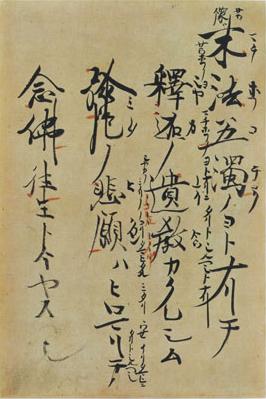
Shinran’s Calligraphy: “Sanjo Wasan” (Kept at Senju-ji Temple)
教義・教学の用語とその解釈
親鸞は浄土真宗の宗祖として知られ、その教えは後世に大きな影響を及ぼしました。
浄土真宗の基本理念は、阿弥陀仏の本願による他力本願の救済を中心に据えています。
比叡山延暦寺などの伝統的な仏教勢力とは異なる立場を取り、鎌倉時代の宗教改革の中で独自の教義を展開しました。
親鸞の教えは、『教行信証』をはじめとする著作によって体系化されています。
この中で、彼は保元の乱や平治の乱といった政治的混乱の中で、平家の興亡や後鳥羽上皇の動向にも言及しつつ、仏教の教義を現実世界に適用する方法を模索しました。
また、承元の法難や六角夢告のような歴史的事件を通じて、親鸞は仏教の教えと社会との関わりを深く考察しました。
これらの出来事は、彼の思想における苦悩と悟りのプロセスを反映しており、浄土真宗の教義の形成に不可欠な要素であったと言えます。
教義・教学の用語においては、親鸞は仏教徒としての信仰のあり方を明確にし、報恩講や親鸞非実在論の議論を通じて、宗教的実践と理論の統合を図りました。
彼の教えは、根本経典への深い洞察と七高僧論釈章疏の研究に基づいており、その解釈は今日に至るまで多くの信者によって受け継がれています。
このように、親鸞の教えは歴史的背景と深く結びついており、その教義と教学の理解にはこれらの用語とその解釈が欠かせません。
親鸞と浄土真宗の歴史を学ぶことは、日本仏教史の理解を深める上で重要な一環と言えるでしょう。
報恩講と親鸞非実在論の議論
親鸞は浄土真宗の宗祖として知られており、その思想は多くの人々に影響を与えてきました。
彼の教えは、保元の乱や平治の乱といった政治的混乱の時代背景の中で形成され、平家の興亡や比叡山延暦寺との関わりを通じて深まったとされます。
鎌倉時代に入ると、六角夢告や承元の法難といった出来事が親鸞の信仰に影響を及ぼし、後鳥羽上皇による仏教改革の動きとも関連が見られます。
親鸞の教えの概要を掘り下げると、浄土真宗の基本理念である他力本願が中心に位置づけられています。
この教えは『教行信証』という著作に詳述されており、親鸞の宗教的な見解が集約されています。
根本経典である『浄土三部経』を始めとする仏教経典の解釈において、親鸞は七高僧論釈章疏を重視し、その教義・教学における用語とその解釈に独自の見解を示しています。
特に、報恩講と親鸞非実在論の議論は、親鸞の教えを理解する上で欠かせない要素です。
報恩講は、親鸞が先師への感謝の意を表すために行った講義であり、彼の教えの実践的な側面を示しています。
一方で、親鸞非実在論は、親鸞が絶対的な実在を否定し、すべての存在は空であるとする教義を指します。
これらの議論を深めることで、親鸞の仏教観をより深く理解することができるでしょう。
Terms and Interpretations in Doctrine and Teaching
Shinran is known as the founder of Jodo Shinshu, and his teachings have had a profound impact on later generations.
The fundamental principle of Jodo Shinshu centers around salvation through Other Power, based on the Vow of Amida Buddha. Shinran adopted a position distinct from traditional Buddhist forces like Mt. Hiei’s Enryaku-ji, developing his own doctrines during the religious reforms of the Kamakura period.
His teachings were systematized in works such as “Kyogyoshinsho.” Amidst political turmoil like the Hojo and Heiji Rebellions, Shinran explored how Buddhist teachings could be applied to the real world, addressing events such as the rise and fall of the Taira clan and the actions of Emperor Go-Shirakawa.
These events reflected Shinran’s struggle and enlightenment process, essential elements in the formation of Jodo Shinshu doctrines.
In terms of doctrine and teaching terminology, Shinran clarified the path of faith as a Buddhist, integrating religious practice and theory through discussions like the Hoonko and Shinran’s theory of non-substantiality.
His teachings, grounded in deep insights into core scriptures like the “Three Pure Land Sutras” and interpretations by the Seven Great Monks, continue to be passed down by many believers today.
Understanding these terms and their interpretations is crucial to grasping Shinran’s doctrines and teachings, deeply intertwined with historical contexts and pivotal in comprehending Japanese Buddhist history.
Discussions on Hoonko and Shinran’s Theory of Non-Substantiality
Shinran, known as the founder of Jodo Shinshu, has significantly influenced many with his philosophy.
His teachings evolved amidst political upheavals like the Hojo and Heiji Rebellions, deepened through the rise and fall of the Taira clan and interactions with Enryaku-ji.
Entering the Kamakura period, events such as the Six-Angle Dream Revelation and the Shoan Persecution affected Shinran’s faith, correlating with Emperor Go-Shirakawa’s Buddhist reform movements.
A deeper look into Shinran’s teachings reveals Other Power as the central tenet of Jodo Shinshu, detailed in works like “Kyogyoshinsho,” summarizing Shinran’s religious perspectives.
In interpreting Buddhist scriptures such as the “Three Pure Land Sutras,” Shinran emphasized the Seven Great Monks’ commentaries, presenting unique views on terminology and their interpretations.
Particularly, discussions on Hoonko and Shinran’s Theory of Non-Substantiality are indispensable for understanding Shinran’s teachings.
Hoonko represents lectures given by Shinran to express gratitude to his predecessors, showcasing the practical aspects of his teachings.
Conversely, Shinran’s Theory of Non-Substantiality denies absolute existence, asserting that all entities are empty.
Further exploration of these discussions enables a deeper understanding of Shinran’s Buddhist perspectives.
親鸞の遺産-著書とその影響力
親鸞は浄土真宗の宗祖として知られ、その教えは日本仏教において重要な位置を占めています。
特に、『教行信証』は彼の思想を体系的にまとめた依拠聖典とされ、後世に大きな影響を与えました。
この著作は、鎌倉時代の混沌とした社会情勢の中で、平家の没落後の政治的な不安定さや、保元の乱、平治の乱といった歴史的背景にも関わらず、仏教の普及という使命を果たしてきました。
親鸞の時代、浄土真宗は比叡山延暦寺のような既存の仏教勢力とは一線を画し、一般庶民にも広く受け入れられる宗教としての地位を確立しました。
承元の法難や六角夢告に見られるように、親鸞自身も迫害を受けながらも、その教えを広めることに尽力しました。
また、後鳥羽上皇の時代には、仏教が政治と密接に関わる中で、親鸞は独自の立場を保持し、彼の教えは多くの人々にとって心の支えとなりました。
親鸞の著書は、その後の歴史小説や子孫による解釈を通じて、さらに多様な形で普及し、今日に至るまで浄土真宗の信者だけでなく、多くの人々に影響を与え続けています。
親鸞の遺産は、単なる宗教的な文献に留まらず、日本の文化や思想においても重要な役割を果たしているのです。
親鸞の著書と教義の普及
親鸞は浄土真宗の宗祖として知られ、その教えは『教行信証』をはじめとする著書を通じて後世に大きな影響を与えました。
鎌倉時代の混沌とした時代背景、特に保元の乱や平治の乱を経験した平家の台頭と比叡山延暦寺の力の均衡は、親鸞の思想形成に間違いなく影響を与えたと言えるでしょう。
六角夢告によって示されたとされる、彼の宗教的な使命感は、承元の法難や後鳥羽上皇の政治的動向とも絡み合いながら、彼の教義の普及に一層の力を添えたのです。
親鸞の教えは、その子孫や数々の歴史小説に描かれることで、より広く知られるようになりました。
彼の教義は、単なる宗教的指導原理にとどまらず、人々の生活の中に深く根ざし、その心の支えとなりました。
『教行信証』は依拠聖典として、浄土真宗の教えを体系化し、親鸞の思想を後の世に伝える重要な役割を果たしています。
親鸞の著書と教義の普及は、彼が生きた鎌倉時代の宗教的、政治的な複雑さを背景に、その深遠なる思想がどのように形成され、伝播していったのかを理解する上で不可欠です。
彼の教えが今日に至るまで、多くの人々に受け入れられ、愛され続けていることは、親鸞の遺産の偉大さを物語っています。
子孫と歴史小説に描かれる親鸞
親鸞は浄土真宗の宗祖として知られ、その教えは日本仏教史において重要な位置を占めています。
彼の生涯は、保元の乱や平治の乱といった動乱の時代背景の中で展開し、平家との関わりや比叡山延暦寺での修行生活が彼の思想形成に影響を与えました。
鎌倉時代の草創期に活動した親鸞は、六角夢告に示されたとされる啓示を受け、仏教の普及に努めました。
承元の法難では、後鳥羽上皇の命により比叡山を追放されるなど、数々の試練を経験しましたが、それらの困難を乗り越えて「教行信証」を著すなど、浄土真宗の教義を確立しました。
「教行信証」は、親鸞の依拠聖典としての地位が高く、彼の教えとその普及に大きな影響を及ぼしています。
親鸞の著書は、信仰の実践において重要な役割を果たし、後世の信者たちに深い敬意を持って読み継がれています。
また、親鸞の思想と生涯は、子孫や多くの作家によって歴史小説に描かれており、その人間性や教えが現代にも伝えられています。
これらの小説は、親鸞という人物をより身近に感じさせ、彼の教えの普遍性を示しています。
親鸞の遺産は、単に宗教的な文献にとどまらず、日本の文化や歴史において、その影響力を色濃く残しています。
彼の教えは、時代を超えて多くの人々に受け継がれ、現代においてもその価値が再評価されているのです。
Shinran’s Legacy – His Writings and Influence
Shinran is renowned as the founder of Jodo Shinshu, holding a significant position in Japanese Buddhist history with his teachings.
In particular, “Kyogyoshinsho” is regarded as the authoritative scripture that systematically encapsulates his philosophy, exerting profound influence in later periods.
Despite the chaotic social conditions of the Kamakura period, including the political instability after the downfall of the Taira clan and historical events like the Hojo and Heiji Rebellions, this work fulfilled its mission of spreading Buddhism.
During Shinran’s era, Jodo Shinshu distinguished itself from existing Buddhist forces like Mt. Hiei’s Enryaku-ji, establishing a firm religious standing widely accepted among the common people.
Despite persecution, such as during the Shoan Persecution and the Six-Angle Dream Revelation, Shinran vigorously propagated his teachings. Amid Emperor Go-Toba’s reign, where Buddhism intertwined closely with politics, Shinran maintained a distinct stance, providing spiritual support to many.
Shinran’s writings have further proliferated through subsequent historical novels and interpretations by his descendants, continuing to influence not only followers of Jodo Shinshu but also many others.
Shinran’s legacy extends beyond mere religious texts, playing a crucial role in Japanese culture and thought.
Dissemination of Shinran’s Writings and Doctrines
Shinran, the founder of Jodo Shinshu, significantly influenced later generations through works such as “Kyogyoshinsho.”
The tumultuous background of the Kamakura period, particularly the rise of the Taira clan amidst the Hojo and Heiji Rebellions, undoubtedly shaped Shinran’s philosophical development.
His sense of religious mission, as evidenced by the Six-Angle Dream Revelation, was bolstered by challenges like the Shoan Persecution and political shifts under Emperor Go-Toba, enhancing the spread of his teachings.
Shinran’s teachings became more widely known through depictions in numerous historical novels and interpretations by his descendants.
Beyond mere principles of religious guidance, his doctrines deeply rooted in people’s lives became a source of spiritual strength.
“Kyogyoshinsho,” as a foundational scripture, systematizes Jodo Shinshu teachings, playing a pivotal role in transmitting Shinran’s philosophy to future generations.
Understanding the dissemination of Shinran’s writings and doctrines is essential to grasping how his profound thoughts were shaped and spread amidst the religious and political complexities of the Kamakura period.
The fact that his teachings continue to be embraced and revered by many today speaks volumes about the greatness of Shinran’s legacy.
Shinran Portrayed in Descendants and Historical Novels
Shinran is celebrated as the founder of Jodo Shinshu, occupying a significant place in Japanese Buddhist history.
His life unfolded against the backdrop of turbulent times like the Hojo and Heiji Rebellions, with influences from interactions with the Taira clan and his training at Mt. Hiei’s Enryaku-ji shaping his philosophical views.
Active in the formative period of the Kamakura era, Shinran received revelations such as the Six-Angle Dream Revelation and dedicated himself to spreading Buddhism.
Despite challenges such as the Shoan Persecution, where he was exiled from Mt. Hiei under Emperor Go-Toba’s orders, he established the doctrines of Jodo Shinshu, culminating in “Kyogyoshinsho.”
“Kyogyoshinsho” holds a revered position as Shinran’s foundational scripture, profoundly influencing his teachings and their dissemination.
Shinran’s writings play a crucial role in the practice of faith, passed down with deep respect by later generations of believers.
Furthermore, Shinran’s life and teachings have been portrayed in historical novels by his descendants and various authors, making his personality and teachings accessible to contemporary audiences.
These novels make Shinran’s persona more relatable and demonstrate the universality of his teachings.
Shinran’s legacy transcends mere religious texts, leaving a profound impact on Japanese culture and history.
His teachings continue to be cherished and reappraised for their enduring value in modern times.
親鸞と現代社会へのメッセージ
親鸞は浄土真宗の宗祖として知られ、その教えは今日においても多くの人々に影響を与えています。
保元の乱や平治の乱といった政治的混乱の時代を生き、平家による支配を見た親鸞は、比叡山延暦寺での修学を経て、鎌倉時代の新しい仏教の形を模索しました。
六角夢告によって示されたとされる真宗の教えは、承元の法難の中でさらに磨かれ、後鳥羽上皇の時代にも影響を及ぼしました。
親鸞の著作『教行信証』は、彼の思想の核心を伝える文献として、現代においてもその価値が認められています。
現代社会における親鸞の思想の意義は、個人の内面的な平和と社会全体の調和を求める点にあります。
浄土真宗と現代の宗教観が交差する中で、親鸞の教えは人々が宗教に求める普遍性と個人的な救済を提供しています。
親鸞の教えが示す平和と共生の道は、対立や争いが絶えない現代社会においても、共感を呼び起こすものです。
彼は、一切の生きとし生けるものが救われるべきであると説き、その慈悲の精神は今日の多様性を尊重し、共存を目指す社会においても尊重されるべきものです。
親鸞のメッセージは、時代を超えて現代人にも有益な指針を提供しており、その教えは今後も多くの人々にとっての精神的な支えとなるでしょう。
現代における親鸞の思想の意義
親鸞の思想は、現代社会においても大きな意義を持ち続けています。
浄土真宗の宗祖として知られる彼は、保元の乱や平治の乱といった動乱の時代に生き、平家による政治の中で比叡山延暦寺に学びました。
鎌倉時代の初期にあたるこの時期は、六角夢告や承元の法難といった事件が社会を揺るがし、後鳥羽上皇の下での政治変動がありました。
親鸞は、そうした混沌とした時代背景の中で、『教行信証』を著し、浄土真宗の教義を確立しました。
その教えは、現代においても人々の心の支えとなり、宗教観を超えた普遍的な価値を提供しています。
親鸞の思想は、平和と共生の道を示すものであり、自己と他者、社会との調和を促すメッセージを含んでいます。
現代社会は情報過多であり、人々の心はしばしば乱れがちです。そんな中で親鸞の教えは、内面の平安を見つけ、他者との共感を深めるための指針を与えてくれます。
浄土真宗という枠を超えて、親鸞の思想は多くの人々にとって、精神的な豊かさを求める旅の一助となるでしょう。
親鸞の思想が現代にもたらす意義は計り知れず、その普遍性は時代を超えて受け継がれていくに違いありません。
個人の内省と社会全体の調和を促進するその教えは、今日においても多くの人々に影響を与え、心の指針となることでしょう。
浄土真宗と現代の宗教観
浄土真宗とは、親鸞によって開かれた仏教の宗派であり、その教えは日本の宗教風土に深く根付いています。
親鸞は、鎌倉時代の混沌とした社会状況の中で、保元の乱や平治の乱といった政治的な動乱を経験し、平家の興亡や比叡山延暦寺での修行生活を通じて、人々の苦悩に寄り添う仏教思想を深めていきました。
六角夢告によって追放された後も、承元の法難に直面しながらも、後鳥羽上皇の支持を受けて、『教行信証』を著し、浄土真宗の宗祖としての地位を固めていきました。
現代社会において、親鸞の思想は多くの人々にとって重要な意義を持ち続けています。
彼の教えは、個人の内面に焦点を当て、心の平安を求める現代人の宗教観と共鳴する部分が多いのです。
また、親鸞の提唱する平和と共生の道は、多様性が認められる現代社会において、宗教間の対話や相互理解を促進する基盤となり得ます。
浄土真宗と現代の宗教観を考える際には、親鸞が示した教えの普遍性と現代性を見出すことが重要です。
彼の思想は、煩悩に満ちた人間であっても救済されるという慈悲深いメッセージを含んでおり、現代人が直面する様々な問題に対しても、その解決の糸口を提供してくれるのです。
親鸞の教えは、単なる宗教的な枠組みを超え、人間としての尊厳や共生の精神を育むための哲学として、今なお多くの人々に受け入れられています。
親鸞の教えが示す平和と共生の道
親鸞は浄土真宗の宗祖として知られ、その教えは今日においても多くの人々に影響を与えています。
彼が生きた鎌倉時代は、保元の乱や平治の乱など、権力争いが絶えず、平家などの武士集団が台頭する時代でした。
そのような混沌とした時代背景の中で、親鸞は比叡山延暦寺で学んだ後、六角夢告を経験し、自身の信仰と宗教観を深めていきました。
承元の法難によって比叡山を追われた後、親鸞は後鳥羽上皇の時代にも活動を続け、その思想を多くの人々に広めました。
彼の著作『教行信証』は、浄土真宗の教義を集大成したものとして、後世に大きな影響を与えています。
親鸞の思想の中心にあるのは、すべての人が救われるべきであるという平等の精神です。
現代社会においても、このような平和と共生の精神は極めて重要であり、異なる文化や価値観を持つ人々が共存するための指針となり得ます。
浄土真宗と現代の宗教観との関連では、親鸞の教えが示す寛容さや共感の重要性が、今日の多様性を受け入れる姿勢に通じるものがあります。
親鸞の生きた時代とは異なり、現代は情報が飛び交い、世界中が繋がる時代です。
しかし、その中で親鸞の教えが示す平和と共生の道は、争いごとを超えた穏やかな共存を目指す私たちにとって、いまだに大きな意味を持ち続けています。
親鸞の思想は、過去にも現在にも、そして未来においても、私たちが目指すべき平和な世界の実現に向けた貴重な指針であると言えるでしょう。
Shinran’s Message to Contemporary Society
Shinran, revered as the founder of Jodo Shinshu, continues to influence many people today through his teachings.
Living through turbulent times like the Hogen and Heiji Rebellions and witnessing Taira clan dominance, Shinran pursued new Buddhist forms during his studies at Mt. Hiei’s Enryaku-ji in the early Kamakura period.
The teachings of Jodo Shinshu, allegedly revealed in the Six-Angle Dream Revelation, were further refined during the Shoan Persecution and influenced the era of Emperor Go-Toba.
Shinran’s work “Kyogyoshinsho” remains valued in modern times as a document conveying the core of his philosophy.
The significance of Shinran’s ideas in contemporary society lies in seeking inner peace for individuals and harmony within society at large.
Amid intersections of Jodo Shinshu and modern religious perspectives, Shinran’s teachings provide universal values and personal salvation sought after in religion.
Shinran’s teachings advocate a path of peace and coexistence that resonates even in today’s society, marked by ongoing conflicts and divisions.
He preached salvation for all living beings, a spirit of compassion that respects diversity and aims for coexistence in societies striving for mutual respect.
Shinran’s message offers valuable guidance to modern individuals, providing spiritual support and serving as a timeless beacon of wisdom.
The Significance of Shinran’s Thought in Contemporary Times
Shinran’s teachings retain profound significance in contemporary society.
Known as the founder of Jodo Shinshu, he navigated through turbulent periods like the Hogen and Heiji Rebellions and studied under the Taira clan’s political dominance at Mt. Hiei’s Enryaku-ji.
During this early Kamakura period, events such as the Six-Angle Dream Revelation and the Shoan Persecution shook society, alongside political shifts under Emperor Go-Toba.
In the midst of such chaotic times, Shinran authored “Kyogyoshinsho,” establishing the doctrines of Jodo Shinshu.
His teachings continue to provide spiritual support and offer universal values that transcend religious beliefs in modern society.
Shinran’s philosophy advocates a path of peace and coexistence, promoting harmony between self and others, and within society.
In today’s information-saturated world, where minds often falter, Shinran’s teachings offer guidance to find inner peace and deepen empathy with others.
Beyond the framework of Jodo Shinshu, Shinran’s thought serves as a companion in the journey for spiritual enrichment sought by many.
The significance of Shinran’s teachings in contemporary times is immeasurable, their universality perpetuated across ages.
His teachings foster introspection and promote harmony within society, serving as a moral and spiritual philosophy that continues to be embraced by many.
The Path of Peace and Coexistence as Illustrated by Shinran’s Thought
Shinran is known as the founder of Jodo Shinshu, and his teachings continue to influence many people today.
Living during the Kamakura period, characterized by constant power struggles such as the Hogen and Heiji Rebellions, Shinran studied at Mt. Hiei’s Enryaku-ji and deepened his Buddhist philosophy in response to people’s suffering.
Even after being exiled due to the Six-Angle Dream Revelation and facing the Shoan Persecution, Shinran continued his work under Emperor Go-Toba’s support, solidifying his position as the founder of Jodo Shinshu through his seminal work, “Kyogyoshinsho.”
At the core of his philosophy is the egalitarian spirit that all beings should be saved.
In contemporary society, this spirit of peace and coexistence remains highly relevant, providing guidelines for coexistence among individuals with different cultures and values.
Considering the relationship between Jodo Shinshu and modern religious perspectives, Shinran’s teachings emphasize the importance of tolerance and empathy, aligning with attitudes that accept today’s diversity.
Unlike Shinran’s era, today’s world is interconnected with abundant information, yet Shinran’s teachings on the path of peace and coexistence remain profoundly meaningful for those of us seeking peaceful coexistence beyond conflict.
Shinran’s thought serves as a valuable guide toward realizing a peaceful world that we aspire to, both in the past and present, and will continue to do so in the future.
参考文献と関連項目
親鸞研究のための参考文献としては、彼の著作『教行信証』が不可欠です。
この書は、浄土真宗の教義を体系的に説明したものであり、親鸞の思想を深く理解するための重要な資料です。
また、浄土真宗の宗祖としての彼の生涯や思想については、『親鸞聖人伝記』や『浄土真宗の歴史』などの研究書も参照すると良いでしょう。
浄土真宗に関連する項目としては、保元の乱や平治の乱といった時代背景が重要です。
これらの出来事は、平家の台頭に大きく寄与し、親鸞が生きた鎌倉時代の社会情勢に影響を与えました。
比叡山延暦寺の歴史も、親鸞の修行の場として、また承元の法難による浄土真宗への迫害の背景として理解することが重要です。
六角夢告や後鳥羽上皇といったキーワードも、親鸞や浄土真宗に関連する歴史的な出来事や人物として注目すべきです。
これらの情報は、親鸞と浄土真宗に関する研究を深める上で役立つでしょう。
リンク集としては、浄土真宗の各派の公式サイトや親鸞に関する学術論文を掲載するデータベースなどが挙げられます。
これらのリソースを活用することで、より詳細な情報を得ることが可能です。
親鸞や浄土真宗について学ぶ際には、これらの参考文献や関連項目を通じて、その時代背景や思想の深さに触れることができるでしょう。
研究者や興味を持つ人々にとって、これらの資料は貴重な知識の源泉となります。
親鸞研究のための参考文献
親鸞研究のための参考文献を探求する際、重要なのはその歴史的背景と思想の理解です。
親鸞は浄土真宗の宗祖として知られ、その教えは多くの文献に記されています。
特に『教行信証』は親鸞の思想を理解する上で欠かせないテキストです。
この書は、彼が比叡山延暦寺で学んだ後、平家の支配が崩壊する保元の乱や平治の乱を経て、鎌倉時代の新しい仏教の流れを作り出したことを示しています。
六角夢告は親鸞に大きな影響を与えたとされ、その後の承元の法難によって浄土真宗はさらに形を変えていきました。
後鳥羽上皇の時代には、仏教の教えが政治にも影響を及ぼすほどでした。
これらの歴史的な出来事は、親鸞の教えと密接に関わっており、研究にはこれらの背景を理解することが不可欠です。
浄土真宗に関連する項目として、親鸞の生涯、彼の教えの核心、そしてその影響を受けた人々や社会についての文献を集めることが推奨されます。
これらの文献を通じて、親鸞の思想がどのように時代を超えて伝えられ、今日に至るまで影響を与え続けているのかを深く理解することができるでしょう。
浄土真宗に関連する項目とリンク集
親鸞は浄土真宗の創始者として知られ、その教えは日本の宗教史において重要な役割を果たしています。
彼の主著『教行信証』は、浄土真宗の教義を詳細に説明しており、研究者や信者にとって貴重な文献です。
親鸞の生涯は保元の乱や平治の乱といった歴史的背景の中で展開し、平家の台頭と滅亡を目の当たりにしました。
平家は、比叡山延暦寺とも深い関わりを持ち、この時代の政治と宗教の複雑な関係を示しています。
鎌倉時代の始まりと共に、新たな仏教の動きが見られ、親鸞もまたその波に乗って独自の教えを開花させました。
六角夢告は、彼の宗教的体験としてしばしば言及され、浄土真宗の信仰における重要な要素となっています。
承元の法難は、仏教内部の対立が社会に与えた影響を示す事件であり、後鳥羽上皇の政治的決断が絡んでいます。
これらの歴史的出来事は、親鸞の思想や浄土真宗の形成に間接的ながら影響を与えたと考えられています。
浄土真宗に関する研究は、これらの歴史的背景や文献を踏まえた上で行われるべきであり、深い理解には広範な知識が必要です。
信者や学生、研究者が親鸞や浄土真宗について学ぶ際には、これらの関連項目をリンク集として掲載し、容易にアクセスできるようにすることが有効です。
References and Related Topics
When researching Shinran, his work “Kyogyoshinsho” is essential as a reference for understanding his teachings within Jodo Shinshu.
This text systematically explains the doctrines of Jodo Shinshu and serves as a crucial source to deeply comprehend Shinran’s philosophy.
Additionally, for insights into his life and thought as the founder of Jodo Shinshu, it’s beneficial to consult biographies such as “The Biography of Saint Shinran” and scholarly works on the history of Jodo Shinshu.
Regarding topics related to Jodo Shinshu, understanding the historical context such as the Hogen and Heiji Rebellions is crucial.
These events significantly contributed to the rise of the Taira clan and influenced the social conditions during Shinran’s lifetime in the Kamakura period.
Understanding the history of Mt. Hiei’s Enryaku-ji is also important, as it was where Shinran pursued his studies and faced persecution within Jodo Shinshu during the Shoan Persecution.
Keywords like the Six-Angle Dream Revelation and Emperor Go-Toba are noteworthy for their historical significance to Shinran and Jodo Shinshu, highlighting pivotal events and figures.
These pieces of information will prove valuable in deepening research on Shinran and Jodo Shinshu.
For a collection of links, databases featuring official sites of various Jodo Shinshu sects and academic papers on Shinran can be listed.
Utilizing these resources enables obtaining more detailed information on the subject.
Exploring these references and related topics provides an opportunity to delve into the historical background and depth of Shinran’s philosophy.
For researchers and those interested, these sources serve as invaluable fountains of knowledge.
References for Shinran Studies
Exploring references for Shinran studies revolves around understanding the historical backdrop and philosophical insights.
Shinran, known as the founder of Jodo Shinshu, is documented in numerous texts.
Particularly, “Kyogyoshinsho” is indispensable for grasping Shinran’s ideology, detailing his path from studies at Mt. Hiei’s Enryaku-ji to the collapse of Taira dominance during the Hogen and Heiji Rebellions, ushering in a new Buddhist movement in the early Kamakura period.
The Six-Angle Dream Revelation profoundly influenced Shinran, further shaping Jodo Shinshu amidst the Shoan Persecution.
The era of Emperor Go-Toba showcased Buddhism’s political impact during Shinran’s time.
These historical events closely intertwine with Shinran’s teachings, necessitating their understanding in research.
Topics related to Jodo Shinshu encompass Shinran’s life, the core of his teachings, and societal figures influenced by them.
Gathering literature on these themes offers insights into how Shinran’s philosophy transcends time and continues to impact today.
For a collection of links, official Jodo Shinshu sect websites and scholarly databases provide access to deeper insights.
In studying Shinran and Jodo Shinshu, these references and related topics offer a profound understanding of their historical context and philosophical depth.
They serve as essential resources for believers, students, and researchers seeking knowledge about Shinran and Jodo Shinshu.
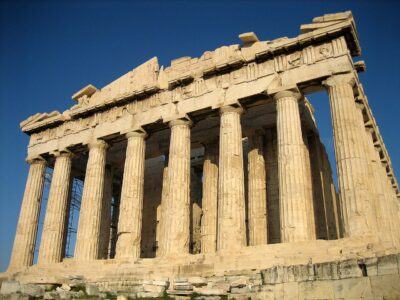
Warning: Undefined variable $comment_form_sns_tags in /home/ktsky/philosophy-kayak.com/public_html/wp-content/themes/shaper/comments.php on line 27
1件のコメントがあります